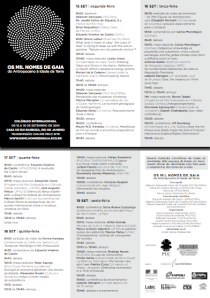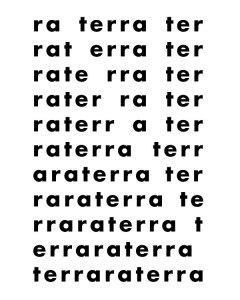Silvia Rivera Cusicanqui: https://www.youtube.com/watch?v=AC_ySMO5-P0
Renzo Taddei: https://www.youtube.com/watch?v=5Dk0svv8cMI
Alf Hornborg: https://www.youtube.com/watch?v=MB1r8r8z8v0
Bronislaw Szerszynski: https://www.youtube.com/watch?v=oqr6bH_U0-o
Felipe Süssekind: https://www.youtube.com/watch?v=zfXs9McoloM
Juliana Fausto & Cecilia Cavalieri: https://www.youtube.com/watch?v=lPd_ggnifZo
Rondinelly Medeiros: https://www.youtube.com/watch?v=f8YQEzQsubY
Marcio Santilli: https://www.youtube.com/watch?v=QJKpMxuyjeM
Cusicanqui, Taddei, Hornborg, Szerszynski, Süssekind, Fausto, Cavalieri, Medeiros and Santilli!
Posted in Uncategorized
Still more videos!
Posted in Uncategorized
Seven more videos!
Alexandre Nodari, Alexandre Costa, Antonio Nobre, Carlos Mondragon, Isabelle Stengers, José Augusto Pádua and Peter Szendy! Take a look!
Posted in Uncategorized
More videos and our youtube channel
We are still uploading the videos of the colloquium! Lesley Green, Patrice Maniglier, Déborah Danowski and Eduardo Sterzi lectures and Maniglier and Green debate are now available on our Youtube channel
Posted in Uncategorized
The first video: Bruno Latour
Now we have our first video! And you can watch Bruno Latour’s speech What does it mean to obey “the Laws of Gaia” in trying to keep up with the old imperative: “Natura non nisi parendo vincitur”? just here:
Posted in Uncategorized
Povinelli, Haraway and many thanks!
Our colloquium was a success! Many thanks to everyone who went to Casa de Rui Barbosa, watched it via streaming and participated in the debate. We were thrilled with the result and we hope that The Thousand Names of Gaia has helped to encourage discussion and action on environmental issues in their various forms and voices.
As they are edited, we are going to make the conference videos available here . For now and by request, here are the two video-interviews that were exhibited during the past week: the wonderful Elizabeth Povinelli and Donna Haraway!
Posted in Uncategorized
Alexandre Nodari: A( )terra(r)
Alexandre Nodari (Cultura e Barbárie and #ATOA) answered the question: “if Gaia has a thousand names, how would you call her?” Click here to view the pdf file
“O que eu quero é muito mais áspero e mais difícil: quero o terreno.” (Clarice Lispector)
Among Gaia’s thousand names (all feminine, I suppose, which is positively symptomatic), I prefer Earth (Terra), especially because it brings us down, to the floor, it grounds (aterra) us, as Déborah Danowski insists. The equivocity present in the term (Earth/earth), planet and soil, as I see it, identifies the world with its material substrate, with that which is underneath us and sustains us, giving us sustenance: our subsistence. I believe that we from #ATOA had this duplicity in mind when we organized, during the People’s Summit (Rio+20), the symposium terraterra (earthearth, in a literal and poor translation), inspired also by Décio Pignatari’s famous concrete poem – which, by the way, highlights such equivocity: Earth (Terra) errs (erra); as every planet, she is a wanderer, an errant. Therefore, Earth is Gaia, but she is also gaiata (a Portuguese term constructed upon the root gai-, designating a happy youngster and/or trickster). In this sense, the “Erratic” proposed by Oswald de Andrade, that science of the “erratic traces” left by Matriarchy in the history of all the peoples, can maybe be understood as an earth science (a terratic), similar to the deleuzian geology of morals, but also and foremost a gaiatology: the gay science not of humans, but of gaiatos, not of the old species that also tries to turn the planet old (humanity), but of that young inhabitant of Gaia yet to come – the science of the bricoleur. To make myself clear: the ongoing environmental catastrophe challenges us to find a way in, using those elements we have at hand (to subsist through an eco-logic of the concrete), and abandoning the engineering logic of the concept that seeks transcendence as a way out (in the limit, a way out of Earth, and even out of the body), and that aims to create a qualified existence, freed from what is “bodily low” – in other words, an extra-terrestrial human life. Georges Bataille used to distinguish between high and low materialisms: while the former is, actually, an idealism, ontologically conceiving matter as a thing-in-itself, that is, as dead matter (this is Meillassoux’s strategy, we must note), the latter, distant from ontology, attempts to think living-matter, focusing on the “putrescence of organic matter” in which humans (and all other beings) plant their roots. Here we come across with another consequence of the equivocity Earth/earth: earth is an oikos as much as Earth is an ego, a subject: “the world is an extremely sensitive animal”, Campanella said several centuries ago, or, to evoke Clarice Lispector’s variant, “the world is extremely reciprocal”. And we encounter such reciprocal ego/oikos equivocity among all inhabitants of the Earth, living and non-living: not only a rock is, on the one hand, a proper being, a whole, but also, on the other hand, it is the house of infinite and infinitesimal particles, a veritable society, as Gabriel Tarde would say – and oikos, the family house, is above all a social and political concept. And the same goes for living beings, including humans: we are, at the same time and inextricably, egos and oikoi. Every human ego is also a multiplicity: “our” body is formed by (is the house of) infinite alien bodies: not only human cells, as well as, to use the most obvious example, those numberless bacteria of the intestinal flora. Such constitutive strangeness (alienation, to play with the Marxist jargon), by which each self is always the house of a multiplicity of other selves, was expressed in several manners throughout history: for example, the unconscious – or even Freud’s Unheimlich (uncanny), which is, in this fashion, a constitutive feeling (nowadays more than ever), given that what is most familiar is also the strangest, and vice-versa. And maybe one of its most interesting expression in Western thought is the stoic idea of oikeiosis, generally translated as “appropriation”: every animal spends his whole life appropriating (relating to) his/her constitution, his/her parts, and, from thereon, appropriating (relating to) that which is good for them and him/herself. If, as the stoics would put it, nature doesn’t estrange animals from themselves, why does she constitute them as proximate and proper to themselves (or belonging to themselves, related to themselves) and not identical to themselves? If there is appropriation/belonging and not identity, then there is difference, immanent difference of the being from itself. But maybe the most curious thing about this stoic notion is that another translation, much more obvious and literal, of the term oikeiosis into modern languages possibly explains better what is at stake: familiarization, or even better, domestication. Every earthly being is a kinship network (of both internal and external relations); it is the building and conservation of houses: every biology is a biography. Habitat is not only a biological category, but a vital (and ethical) choice; every habitat is a habit, the consistency acquired by the inter-relation of the multiplicity of beings and intensities which inhabit each being. The self’s habit is the habitat of many; life is a “state of contact”, as Lispector would put it. But we should not infer that such duplicity ego/oikos implies a harmony, quite the opposite: it generates noise, problems, equivocal echoes between the ego and the oikos. Every other (even those that inhabit us) is dangerous, dangerous due to its otherness, as every other is, in the limit, unknown: we are sure what to expect from it. Therefore, we could say that there are basically two forms of domestication, or two ways of conceiving domestication. The first of them is the dominant strategy of eliminating danger through security, silencing or controlling every error, echo or noise from our own bodies, the animals or the “environment”. Such strategy attempts to build a safe house (safe for humans, of course) by means of domination and seclusion from Earth and from the earth, from animality and from every low matter: we can name it “messianism” (be it political or religious), as it seeks to build an extra-terrestrial house (life), freed from all necessity. But there is also another strategy, or even better, a multitude of counter-strategies which attempt to preserve to a maximum the equivocal zone of echoes, the passage between ego and oikos (somehow, the difference between both strategies that I here evoke resonate Lévi-Strauss’ distinction of antropoemetic and antropophagic societies) – a passage we can name as “obliquation”, or “oblique life” (to use Lispector’s term, which indicates a passage between I and me, subject and object, that makes possible every inter-locution and translatability). These counter-strategies are not forms of unipolar domestication; they are modes of co-domestication, co-oikeiosis in which reciprocity and not unilateralism assumes the main role. And I believe we may call them, following Guattari, forms of “eco-logic”, the “logic of intensities”, but also an (equivocally) echoing speech, a logic of reciprocity. Every ecology is also an echology, a resonation of the ego in others and vice-versa; and it is as well an equivocology, the same voice (house), but always different; in sum, it is the echo of ego’s equivocity, the ego equivocally echoing the oikos that it also is (and reciprocally). Ego-logy, echo-logy, oiko-logia, equivo-logy: eQologia, to make use of Glauber Rocha’s poetical procedure, which consists in changing the spelling of some words without affecting its sonority (for example: “brazyleiro”, with a “z” and a “y” replacing the original “s” and “i”, and therefore inserting a dis-identification in the very core of national identity and producing a difference inside the sameness), thus showing performatively the multiplicity concealed in every unicity. Therefore, ecology/eQology isn’t a science about Earth, but a speech of Earth, as she is a subject (ego) whose habits are composed by the reciprocal (echoing) relation with those who inhabit her (that take her as their oikos). We must learn to hear these echoes of Earth/earth, among other reasons because we also speak at each of her speeches: every inter-locution is an equi-vocity. And we must also echo those speeches and the reciprocity entailed in every echo, a reciprocity that the anthropocentric strategy of domination seeks to silence at all costs – even human extinction.
Alexandre Nodari, August 2014.
Posted in Uncategorized
Renzo Taddei
Another interview! Renzo Taddei is a professor at the Graduate Program in Social Sciences and at the Sea Institute of the Federal University of São Paulo (UNIFESP). An engineer-turned-anthropologist, his research focuses on the different ways to understand and live the atmosphere; and he has done field research among meteorologists and the so-called “rain prophets” of the backlands of Brazil’s Northeastern region. Taddei edited, with Ana Laura Gamboggi, the book After the Rain Did Not Come: Social Responses to Drought in the Amazon, the Northeast and the South of Brazil (2010). The title of his lecture at our colloquium is Altergeoengeneering, in which he will discuss the relation between climate engineering and cultural contexts where the understanding of the environment does not reproduce the materialist (or naturalist, to use the term proposed by Philippe Descola) standards of the Western thought and are more connected to the animistic forms of relationship between humans and the elements – in particular, he will talk about how Amerindian and Afro-brazilian traditions think the theme of the manipulation of the atmosphere, and how they can contribute to the debate about geoengineering. In the video, he talks about the prophets of rain and the Coral Snake Chief, among others, and gets a very special visit at 7’38 “. Take a look! To turn the subtitles on, click the captions icon, then Turn Captions On.
Posted in Uncategorized
chipping in!
Hi folks,
We are currently accepting contributions to reach the budget of the colloquium The Thousand Names of Gaia – From the Anthropocene to the Age of the Earth. If you wish to help us to make it happen, please send an email to osmilnomesdegaia@gmail.com, so as we can send you the instructions. Thank you so much in advance! 🙂
Posted in Uncategorized


